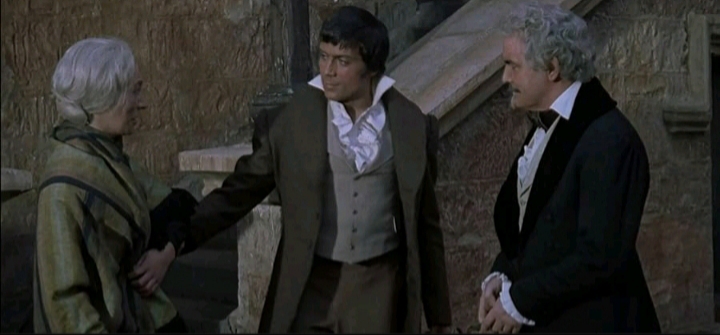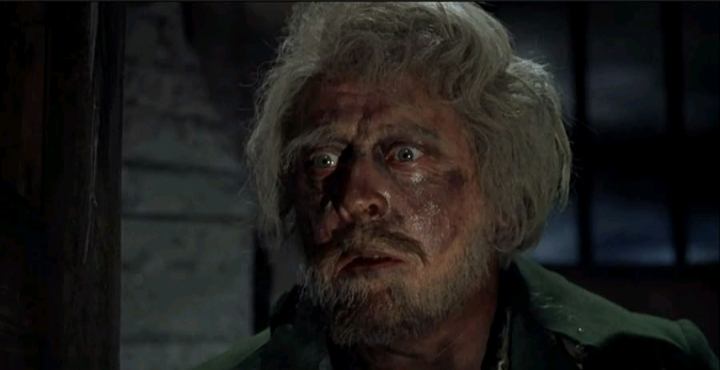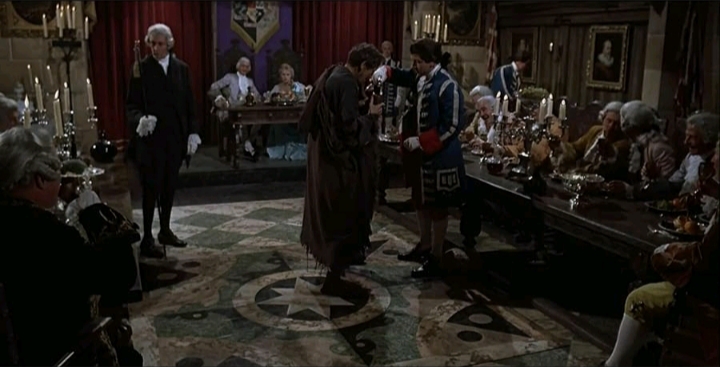EVEN THOSE WHO LOVED HIM WERE NOT SAFE!
A BLOODY ASYLUM SPOILER-FREE REVIEW OF A HAMMER HORROR CLASSIC
Following on from SHE, my first experience of a Hammer film as a 5-year-old, THE CURSE OF THE WEREWOLF would just a couple of years later be my first horror movie proper.
And WOW! What a massive impression it made on my young self. Images and scenes etched into the memory for over 50 years. Specifically, the opening wedding banquet wherein a homeless beggar is cruelly mocked by the obscenely rich groom and guests. A sequence still more disturbing than much of the horror that follows.
My passion for edgy, humanistic, character-centric horror can probably be traced back to one of Hammer’s definitive films. The cornerstone of my lifelong love of their movies.
Released in May 1961, THE CURSE OF THE WEREWOLF is widely considered one of Hammer’s very best. Yet surprisingly it was the only werewolf film they produced. As the first werewolf movie filmed in colour, it would go on to influence cinematic horror much like Universal’s THE WOLFMAN two decades before. Over 60 years later it still holds up as one of the all-time great movies from the golden age of classic horror.
Having previously adapted DRACULA, FRANKENSTEIN, and THE MUMMY it was inevitable Hammer would turn their attention to the werewolf. All three were directed by Terence Fisher who is credited more than any other with creating their unique style. So it was no surprise he would again be in the director’s chair. The distinctive, economical, streamlined Hammer screenplay by Antony Hinds writing as always under the pseudonym John Elder was based very loosely on the novel WEREWOLF OF PARIS by Guy Endore.
In eighteenth-century Spain Leon, a young adopted boy, becomes a werewolf and terrorizes the inhabitants of his town.
The script was shaped to work within the setting changed from France of the novel to Spain to save money as sets were already constructed for another movie set during the Spanish Inquisition. This enforced change added immensely to the finished film and the unique overall aesthetic for the werewolf genre at the time.
THE CURSE OF THE WEREWOLF is among one of Hammer’s most emotionally involved due in no small part to Oliver Reed in his first lead role as Leon. Although not appearing until nearly halfway through still he makes a lasting impression, showing why he would go on to become one of the finest and most daring actors of his generation.
Fisher and Hinds were quite obviously aware a slow-burn narrative was essential to underscore the human aspect. Reed was instrumental in this. Fuelled by his performance, even when his full transformation make-up is finally revealed. Perfectly depicting with gradually mounting intensity the horror and desperation Leon feels. To the eventual realisation of what is happening to him. For this is a film that stands or falls on Reed. And he more than delivered. Grabbing the chance for all it was worth with his moving portrayal of a young man unable to control the affliction of becoming a murderous creature at every full moon. Michael Ripper said that Reed’s intensity scared him when the camera was rolling, which further bolstered their shared scenes. Perfectly highlighting Reed’s committed performance is a sequence involving a door which he grabs and throws. It was in fact made of timber and not the usual light balsa wood.
When Reed was asked in a 1984 interview what movie he would be remembered for he singled out THE CURSE OF THE WEREWOLF because he felt it was one of his best. Going on to say that it was also one of his most enjoyable filming experiences. Adding that working on several Hammer films taught him many things that helped him learn his craft as an actor.
Reed was no doubt helped by being in the company of one of the best ensemble casts to ever appear in a classic British horror, with the veterans on hand to inspire him.
Headed up by Clifford Evans (KISS OF THE VAMPIRE), with Hira Talfrey (WITCHFINDER GENERAL, THE OBLONG BOX) as Leon’s loving and nurturing adoptive parents.
Laying down the foundation of the heart of the story early on is Yvonne Romain (CAPTAIN CLEGG, CIRCUS OF HORRORS, CORRIDORS OF BLOOD). Exceptional as the mute servant girl who gives birth to Leon. Touchingly depicting each emotion in every look and expression.
Catherine Feller as Christine, the woman adult Leon loves, has a believable chemistry with Reed that again re-enforces the human aspect. Both she and Romain, in thinly written roles, like many Hammer actresses created rounded characters that at times transcended the Hammer Glamour tag.
In more or less a supporting role is Warren Mitchell. Many in the UK will know him as Alf Garnett from the sitcoms TILL DEATH US DO PART and IN SICKNESS AND IN HEALTH and may well be surprised to discover he was first and foremost a top-class character actor. In only a few scenes making a big impression.
Hammer regular Ripper, who appeared in more of their films than any other actor, appears briefly, but as ever memorably, as a prison inmate.
However, having a lasting impact on the young me more than any other character was the disturbingly convincing Anthony Dawson (Dial M for Murder, Dr No, From Russia with Love) as the vile groom, Marques Siniestro. More horrifying than any creature Hammer brought to the screen.
The cast aided immensely by Hammer’s always stellar craftsmanship behind the camera. Cinematographer Arthur Grant shows off in all its splendour the ever-exquisite production design by Bernard Robinson that once again transformed the small Bray studios into seemingly vast sets.
Roy Ashton’s werewolf make-up at each transformation stage for both Reed and his stunt double was inspired in its economical design and application. When in full make-up Reed took great delight in scaring cast, and crew. Even on one occasion pranking patrons at a local pub by revealing his hair-adorned body when taking off his shirt.
Finally, every aspect is complemented to perfection by Benjamin Frankel’s evocative score.
At the time this was one of two scripts Hammer had in development. THE RAPE OF SABENA being the other. Both ran into censorship problems. Even though the British Board of Film Censors warned them not to make either they nevertheless went ahead with THE CURSE OF THE WEREWOLF.
Although tame by today’s standards, it was not surprisingly their most controversial film up to that point. Hammer as ever aimed to push the boundaries of what could be depicted on screen. On this occasion, they went too far for the censor’s liking. The combination of far more explicit violence and sex ran foul of the BBFC even at the screenplay stage. At that time all scripts had to be submitted to them for approval before filming could commence.
Yet the problems for Hammer did not end there. THE CURSE OF THE WEREWOLF would subsequently run into more censorship problems. About 5 minutes of enforced cuts had to be made before release, and even more for the US release. The BBFC ordered pretty much all of the violence, blood, and sex to be excised. Integral parts of the narrative that when removed were detrimental to the film’s effectiveness. Reed’s wonderful performance was severely compromised in some scenes, notably the finale, along with key death scenes. Everything excised harmed the narrative flow and impact at crucial times. However, Hammer had no choice but to release this brutally truncated version. This had the effect of their subsequent films being far less graphic.
Only in recent years realising the version I first experienced back in the 1970s on TV was this compromised cut. It would be 30 years later in the early 1990s when the BBC aired the fully restored uncut version and Terence Fisher’s vision was finally shown in all its glory.
On a side note, it should be pointed out that the censorship issues inadvertently had a positive effect. Hammer would go on to produce some very impressive psychological horrors throughout the 1960s and 1970s. PARANOIAC with Reed is one of the standouts that is well worth checking out.
Not unexpectedly on its original cinema release THE CURSE OF THE WEREWOLF was in some quarters critically mauled for its graphic nature, as was commonplace with most Hammer horrors. Nonetheless, overall it garnered very favourable reviews even though it did not quite have the box office success of CURSE OF FRANKENSTEIN or DRACULA. Yet it would go on to be one of their most beloved films.
Revisiting THE CURSE OF THE WEREWOLF yet again memories as ever came flooding back of first experiencing with my grandparents one of my favourite Hammer movies and among those that stands at the pinnacle of British horror.
On Blu-ray it looks and sounds better than anyone involved in its production could ever have imagined. Details being revealed that were pretty much lost in earlier releases. Such as a tear from Reed’s eye that heightens a gut-punch moment.
To round off, just a few words about the version reviewed here. THE CURSE OF THE WEREWOLF is included in the UK five-disc HAMMER THE UNIVERSAL YEARS released in 2015 by Final Cut. Each movie is beautifully remastered. Including plentiful extras spread over the four. Others in the set are BRIDES OF DRACULA, KISS OF THE VAMPIRE, and CAPTAIN CLEGG. On the fifth disc is a revealing documentary covering the Universal years.
A highly recommended collection for fans and not a bad place to start for those wanting a flavour of Hammer.
In the US Scream Factory also released THE CURSE OF THE WEREWOLF as what seems to be an impressive blu ray.
Original The Bloody Asylum Facebook post:















